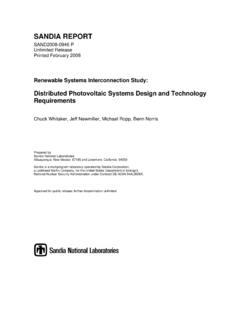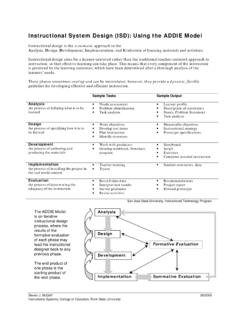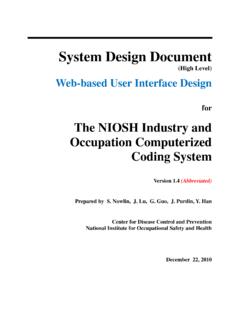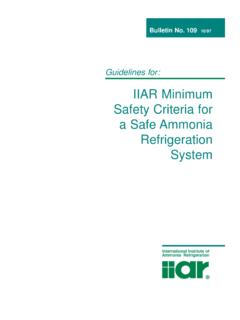Transcription of Ground Ambulance Data Collection System Sampling ...
1 Centers for Medicare & Medicaid Services Centers for Medicare & Medicaid Services CMS Alliance to Modernize Healthcare (The Health FFRDC). A Federally Funded Research and Development Center Medicare Ambulance Services Special Analysis Task Order No. HHSM-500-T0052. Medicare's Ground Ambulance Data Collection System : Sampling and Instrument Considerations and recommendations Final July 30, 2019. The views, opinions, and/or findings contained in this report are those of The MITRE Corporation and should not be construed as official government position, policy, or decision unless so designated by other documentation. 2019, The MITRE Corporation. All Rights Reserved. Medicare's Ground Ambulance Data Collection System : Sampling and Instrument Considerations and recommendations 2019 The MITRE Corporation. ALL RIGHTS RESERVED. Approved for Public Release: 19-0989. Distribution Unlimited. Centers for Medicare & Medicaid Services Authors of this Report (the Health FFRDC Team).
2 Andrew Mulcahy (RAND). Kirsten Becker (RAND). Jonathan Cantor (RAND). Scott Ashwood (RAND). Jeanne Ringel (RAND). Lisa Sontag-Padilla (RAND). Christine Buttorff (RAND). Michael Robbins (RAND). Susan Lovejoy (RAND). Thomas Goughnour (RAND). Sara Heins (RAND). Beverly Weidmer (RAND). Monique Martineau (RAND). Mike Oelrich (MITRE). Jennifer Gildner (RAND). Gina Karimi (RAND). Thomas Goode (RAND). Medicare's Ground Ambulance Data Collection System : Sampling and Instrument Considerations and recommendations ii 2019 The MITRE Corporation. ALL RIGHTS RESERVED. Approved for Public Release: 19-0989. Distribution Unlimited. Centers for Medicare & Medicaid Services Acronyms Acronym Definition AAA America Ambulance Association ACS American Community Survey AFS Ambulance Fee Schedule ALS Advanced Life Support BBA Bipartisan Budget Act of 2018. BLS Basic Life Support CAH Critical Access Hospital CDC Centers for Disease Control and Prevention CES Cost Element Structure CMS Centers for Medicare & Medicaid Services EMR Emergency Medical Responder EMS Emergency Medical Services EMSCAP Emergency Medical Services Cost Analysis Project ESRD End-Stage Renal Disease FDA Food and Drug Administration FFRDC Federally Funded Research and Development Center FTE Full-Time Equivalent GAO Government Accountability Office GEMT Ground Emergency Medical Transportation HCPCS Healthcare Common Procedure Coding System HCRIS Healthcare Cost Report Information System HHS Department of Health and Human Services HIPAA Health Insurance Portability and Accountability Act HRSA Health Resources and Services Administration IAFC International Association of Fire Chiefs IAFF International Association of Fire Fighters IDR Integrated Data Repository IOM Institute of Medicine MedPAC
3 Medicare Payment and Advisory Commission NAEMT National Association of Emergency Medical Technicians Medicare's Ground Ambulance Data Collection System : Sampling and Instrument Considerations and recommendations iii 2019 The MITRE Corporation. ALL RIGHTS RESERVED. Approved for Public Release: 19-0989. Distribution Unlimited. Centers for Medicare & Medicaid Services Acronym Definition NASEMSO National Association of State EMS Officials NHSTA National Highway Transportation Safety Administration NPI National Provider Identifier NPPES National Plan and Provider Enumeration System NRHA National Rural Health Association NVFC National Volunteer Fire Council ONC Office of the National Coordinator for Health Information Technology PDF Portable Document Format PECOS Provider Enrollment, Chain and Ownership System RVU Relative Value Unit SNF Skilled Nursing Facility SUV Sport Utility Vehicle Medicare's Ground Ambulance Data Collection System : Sampling and Instrument Considerations and recommendations iv 2019 The MITRE Corporation.
4 ALL RIGHTS RESERVED. Approved for Public Release: 19-0989. Distribution Unlimited. Centers for Medicare & Medicaid Services Executive Summary Introduction The Bipartisan Budget Act of 2018 (BBA of 2018); Public Law 115-123, Section 50203(b). requires the Secretary of the Department of Health and Human Services (HHS) to develop a data Collection System to collect data on costs, revenue, and utilization, and other information deemed appropriate by the Secretary, from a representative sample of entities that furnish Ground ( , land and water) Ambulance services. The BBA of 2018 specifies that the data Collection System applies to Medicare Ambulance providers hospitals and other facilities that are Medicare providers of service and Medicare Ambulance suppliers all other organizations that enroll in Medicare specifically to furnish and bill for Ground Ambulance services. The BBA of 2018. further requires the Medicare Payment Advisory Commission (MedPAC) to use the collected data to assess the relationship between Medicare's payment rates and the cost of providing Ground Ambulance services.
5 The Center for Medicare and Medicaid Services (CMS) commissioned support from the CMS. Alliance for Modernizing Health Care Federally Funded Research and Development Center (the Health FFRDC) in developing the data Collection instrument and Sampling plan to meet these requirements. This report summarizes the Health FFRDC's work under this effort, including: An overview of the Ground Ambulance industry (Chapter 2). A summary and comparison of existing tools to collect information related to Ground Ambulance costs, revenue, and volume (Chapter 3). Findings from discussions with Ground Ambulance providers and suppliers (collectively, Ground Ambulance organizations 1) and industry groups (Chapter 4). Analysis of Ground Ambulance organization characteristics and Medicare Ground Ambulance service volume and mix using available Medicare data (Chapter 5). The final chapters of the report present the Health FFRDC's recommendations to CMS regarding the development of a Sampling plan (Chapter 6) and an instrument to collect data (Chapter 7) to meet the requirements specified in the BBA of 2018.
6 We include a data Collection instrument consistent with our design recommendations in an appendix to this report (Appendix E). The findings in Chapters 2 through 5 describe our work to arrive at our recommendations and offer support for specific recommendations . Readers primarily interested in the Health FFRDC's recommendations are directed to Chapters 6 and 7 and the instrument in Appendix E. Ground Ambulance Services in Medicare Medicare covers medically necessary Ground Ambulance services meeting certain conditions. 2. These services are provided by a diverse set of organizations enrolled in Medicare as providers or suppliers, including fire departments, hospitals, stand-alone government agencies, non-profit 1 Air Ambulance organizations and services are out of scope for both CMS's Ground Ambulance data Collection System and for this report. 2 In addition to medical necessity, Medicare requires that (a) transports are to the nearest appropriate facility given the patient's condition, and (b) all other forms of transportation are contraindicated.
7 Medicare's Ground Ambulance Data Collection System : Sampling and Instrument Considerations and recommendations v 2019 The MITRE Corporation. ALL RIGHTS RESERVED. Approved for Public Release: 19-0989. Distribution Unlimited. Centers for Medicare & Medicaid Services organizations, and private for-profit companies. While most Medicare transports are covered by the Medicare Part B medical benefit, transports involving inpatients at a hospital or other facility fall under the Part A hospital benefit. Medicare pays Ambulance organizations 3 for Part B-covered transports using the Ambulance Fee Schedule (AFS). The AFS establishes a base rate that varies by the level of transport provided ( , basic life support vs. advanced life support). The AFS also includes a per-mile rate applied to the distance traveled with the patient. The AFS incorporates a permanent add-on payment of a 50 percent increase in the standard mileage rate for Ground Ambulance transports that originate in rural areas where the travel distance is between 1 and 17 miles.
8 Both base and mileage payments are only made when a patient is transported in other words, Medicare does not pay for Ambulance responses to calls for service that do not result in a patient transport. Since the inception of the AFS in 2002, the base and mileage payment rates have been modified by three temporary add-on payments that are higher for transports originating in rural areas. These add-ons have been extended several times, most recently by the BBA of 2018. Challenges in Comparing Payment Rates to Costs Assessing how Medicare payment rates are related to costs is complicated by the significant variation in Ambulance organizations and by differences in how Ambulance services are delivered and financed across communities. Ambulance organizations vary in the mix of services they provide, including the share of responses resulting in transport, the blend of emergency and non- emergency transports, and, even within emergency and non-emergency transport categories, the level of transport.
9 4 Different types of services require different capabilities and inputs and therefore contribute differentially to organizations' costs. Furthermore, many Ambulance organizations share personnel, facilities, and vehicles with other services such as fire departments or hospitals. Determining the specific share of costs that should be allocated to their Ambulance services for the purposes of comparing payments to costs is challenging. Furthermore, manyambulance organizations receive significant revenue from communities to support emergency medical services (EMS) systems with varying capabilities. It is not clear how Medicare and other healthcare payers' rates should align with costs in this case. Neither is it clear whether payments should cover the total costs involved in furnishing Ambulance services, including the costs of responses that do not result in billable transports, or only the costs associated with patient transports.
10 3 The BBA of 2018 and this report focus on Ground Ambulance organizations and Ground Ambulance services (as opposed to air Ambulance organizations and air Ambulance services). Air Ambulance organizations and services are out of scope for this report. For the remainder of the Executive Summary, we use Ambulance organization . and Ambulance service to refer to Ground Ambulance organization and Ground Ambulance service, . respectively. 4 Transports are provided and billed to Medicare as either Advanced Life Support (ALS) or Basic Life Support (BLS). based on the staff and resources involved in the response. There is further differentiation in the AFS between levels of ALS transports, Specialty Care transport, and Paramedic Intercept, which is an ALS level of service that CMS defines as: a rural area transport furnished by a volunteer Ambulance company which is prohibited by state law from billing third party payers where services are provided by an entity that is under contract with the volunteer Ambulance company that does not provide the transport but is paid for their paramedic intercept service.
















